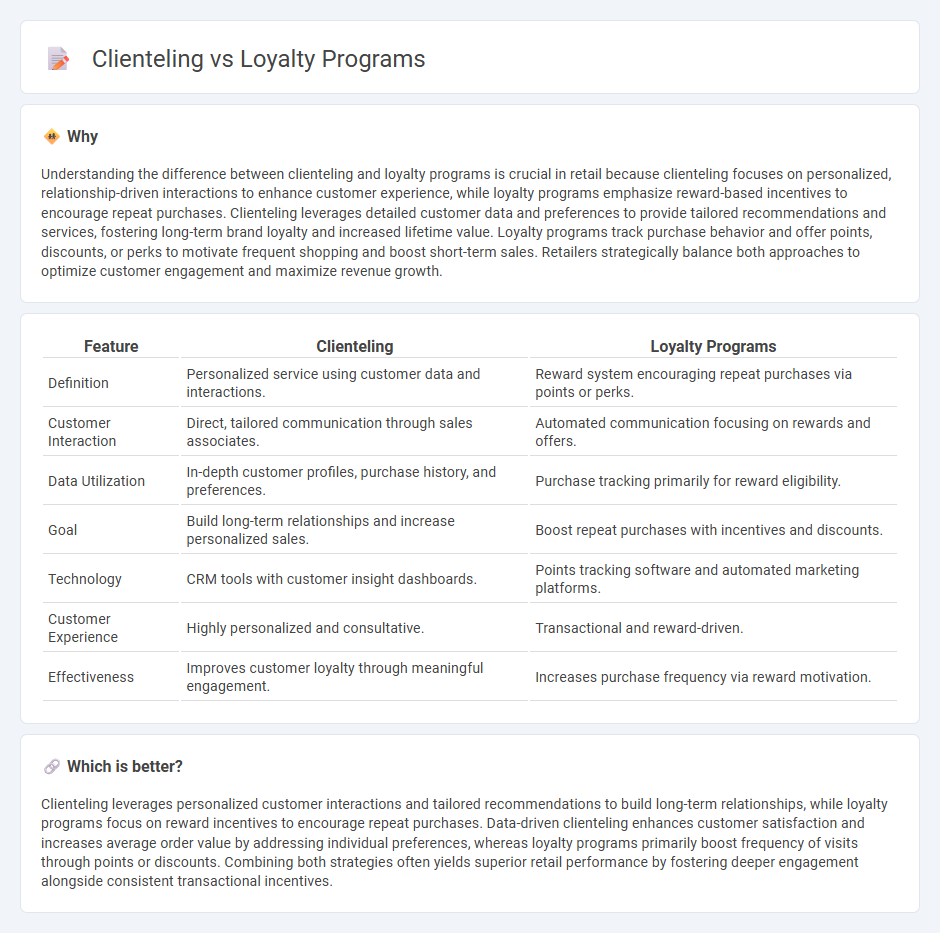
Clienteling enhances personalized customer experiences through tailored interactions and data-driven insights, while loyalty programs focus on rewarding repeat purchases to encourage brand retention. Both strategies aim to increase customer lifetime value but employ different methods: clienteling emphasizes individualized service, whereas loyalty programs leverage incentive structures. Discover how these approaches can transform your retail strategy effectively.
Why it is important
Understanding the difference between clienteling and loyalty programs is crucial in retail because clienteling focuses on personalized, relationship-driven interactions to enhance customer experience, while loyalty programs emphasize reward-based incentives to encourage repeat purchases. Clienteling leverages detailed customer data and preferences to provide tailored recommendations and services, fostering long-term brand loyalty and increased lifetime value. Loyalty programs track purchase behavior and offer points, discounts, or perks to motivate frequent shopping and boost short-term sales. Retailers strategically balance both approaches to optimize customer engagement and maximize revenue growth.
Comparison Table
| Feature | Clienteling | Loyalty Programs |
|---|---|---|
| Definition | Personalized service using customer data and interactions. | Reward system encouraging repeat purchases via points or perks. |
| Customer Interaction | Direct, tailored communication through sales associates. | Automated communication focusing on rewards and offers. |
| Data Utilization | In-depth customer profiles, purchase history, and preferences. | Purchase tracking primarily for reward eligibility. |
| Goal | Build long-term relationships and increase personalized sales. | Boost repeat purchases with incentives and discounts. |
| Technology | CRM tools with customer insight dashboards. | Points tracking software and automated marketing platforms. |
| Customer Experience | Highly personalized and consultative. | Transactional and reward-driven. |
| Effectiveness | Improves customer loyalty through meaningful engagement. | Increases purchase frequency via reward motivation. |
Which is better?
Clienteling leverages personalized customer interactions and tailored recommendations to build long-term relationships, while loyalty programs focus on reward incentives to encourage repeat purchases. Data-driven clienteling enhances customer satisfaction and increases average order value by addressing individual preferences, whereas loyalty programs primarily boost frequency of visits through points or discounts. Combining both strategies often yields superior retail performance by fostering deeper engagement alongside consistent transactional incentives.
Connection
Clienteling enhances customer relationships by leveraging personalized data to tailor experiences, which drives higher engagement in loyalty programs. Loyalty programs reward repeat purchases, encouraging customer retention and increasing lifetime value through targeted incentives linked to clienteling insights. The integration of clienteling and loyalty programs enables retailers to deliver customized promotions, fostering deeper brand loyalty and improved sales performance.
Key Terms
Customer Retention
Loyalty programs offer structured rewards to incentivize repeat purchases, while clienteling uses personalized interactions to build deeper relationships with customers, enhancing long-term retention. Data-driven clienteling leverages customer preferences and purchase history for tailored experiences, often resulting in higher engagement than generic loyalty incentives. Explore how combining loyalty programs and clienteling strategies can maximize customer lifetime value and retention.
Personalization
Loyalty programs primarily offer rewards and incentives based on purchase history, enhancing customer retention through points, discounts, and exclusive offers. Clienteling emphasizes personalized customer experiences by leveraging data insights and direct communication to tailor recommendations and service, fostering deeper emotional connections. Explore how combining the strengths of both strategies can elevate your customer engagement and drive sustained loyalty.
Purchase History
Loyalty programs reward customers based on accumulated purchase history, encouraging repeat business through points and discounts. Clienteling leverages detailed purchase data to personalize shopping experiences, fostering deeper customer relationships and higher lifetime value. Explore how integrating both strategies can maximize customer retention and sales growth.
Source and External Links
Loyalty Programs: How They Work, Examples, and Tips - Discusses various types of loyalty programs, including points-based, tier-based, and mission-based programs, offering insights into how they work and their benefits.
10+ Businesses with the Best Loyalty Programs [2025] - Highlights successful loyalty programs from businesses like My Bath & Body Works, Amazon Prime, and Starbucks Rewards, focusing on their strategies and customer engagement.
Loyalty Program - Wikipedia - Offers a comprehensive overview of loyalty programs, including their types, benefits, and how they function as marketing strategies.
 dowidth.com
dowidth.com